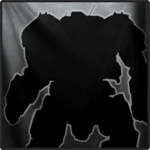The goal of combat is to kill your enemy, but more specifically, for your team to kill the enemy team. The success of this depends on you playing a role. The execution of this role varies depending on the mech you have chosen to play, but the following principles are applicable to all mechs.
Why to stay with your team.
Fair fights tend to lead to a lot of damage sustained on both sides. It is important to make the fight as unfair as possible for your enemy in order to maximize the amount of damage your team can do, while minimizing the amount of damage taken in return.
The direction a mech is facing is their zone of threat. Enemy mechs are more dangerous when they are facing you. Attacking them head on is the easiest way to make a fight fair, as both you and the enemy mechs will have line of sight and line of shot. If you can hit them, they can hit you. Because of this, it is important to hit your enemies from the side or behind.
If you are the only threat presented to an enemy, they will face you, and you will therefore be in their zone of threat. The best way to get a mech to turn away from you is for a teammate to apply a bigger threat from a different direction. This is why the team must stick together - because you need to work together to create angles on the side and back of your enemies.
Work with your team to draw fire and seek cover, and move forward and apply threat.
Where to be in a fight.
Because you are not fighting face to face with your opponent, you must have cover. But because you also need to apply pressure on them, you need to be in a position where you can see (and shoot) your enemy. This means that you should be in an area of cover, which you can easily emerge from to apply your damage, and then easily return to. These things are important:
If you are in cover but not able to apply pressure, you are not helping your team. If you are able to apply pressure but you have no cover, you will soon be killed by the enemy.
There are important things to keep in mind as you search for appropriate cover/firing positions:
Where is the enemy, and which direction are they moving?
Where is your team, and which direction are they moving?
Where will the enemy come from when they engage your position?
Have you got cover and a firing line from every direction they could come?
Where will you fall back to if the enemy forces you from your cover?
Can I safely get into a better firing position?
If your current firing position will soon be overwhelmed, retreat to the next piece of cover. If you have no cover, you can still attempt to run. Mechs are tough - survive and draw the enemy into your team's zone of threat.
What happens in a fight.
When two teams clash, the mechs crunch together like thundering iron. A battle line will be formed based on where each individual chooses as their firing position. Sometimes the battle line will hold this way while the teams exchange fire. Sometimes one team will aggressively push forward and break the enemy lines. Sometimes one team will walk into the enemy line and be blown apart. Sometimes one team fails to get into good firing positions and the other team takes a large positional advantage.
Whatever happens, think of the battle line as the zone of threat that both teams put onto the battlefield. Attempt to fill any holes in your team's zone of threat, and attempt to disrupt the enemy firing positions by flanking them.
When to brawl.
Brawling is as close as you will get to face to face combat, however the principles above still apply. Don't get into a brawl unless you will have a better firing position on your enemy. If you can still do your damage from range (and will be safer there), then stay at range. There is no need to expose yourself to risk. Hit the enemy from close range if you can get close safely, but do not be committed to the destruction. Be prepared to retreat should the battle start to go against you.
When to shoot.
Shoot your weapons when you will hit with them. Take extra time to make sure the shot will be on target. A hastily fired shot that misses will do less damage than a well aimed shot that hits.
If you are at risk of hitting a teammate with your weapons, don't fire them. It is better to not do damage than to damage your own team. Especially be careful to not hit your allies with big weapons such as Gauss rifles, as these will hurt a lot. Remember, if you hit your ally you missed your enemy.
If you accidentally fire a beam weapon at your ally, quickly swing your aim away so as to minimize the damage you deal, and to spread the damage over multiple parts. It's better to damage your ally a little bit in a few places than a lot in one place.
If you enjoyed this guide look up my other guides in the new players forum.
Thank you.
Edited by PeenyPoke, 20 July 2013 - 10:07 AM.



















